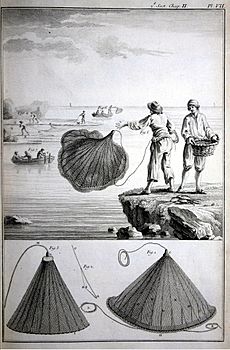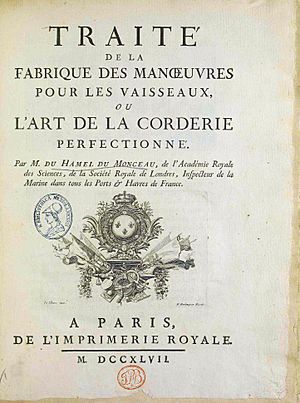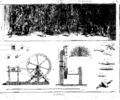Henri-Louis Duhamel du Monceau facts for kids
Quick facts for kids
Henri-Louis Duhamel du Monceau
|
|
|---|---|
 |
|
| Born | 20 July 1700 |
| Died | 13 August 1782 (aged 82) |
| Nationality | French |
| Scientific career | |
| Fields | Botany |
Henri-Louis Duhamel du Monceau (born July 20, 1700, in Paris; died August 13, 1782, in Paris) was a famous French scientist. He was a physician, a naval engineer (someone who designs ships), and a botanist (someone who studies plants). He made many important discoveries in different fields.
Contents
About Henri-Louis Duhamel du Monceau
Henri-Louis Duhamel du Monceau was born in Paris in 1700. His father was a lord, a person of high rank. When he was young, Henri-Louis loved studying botany, which is the science of plants. However, his father wanted him to study law, so he did that from 1718 to 1721.
His Model Farm and Experiments
After his father passed away, Henri-Louis inherited a very large estate. He turned this estate into a special "model farm." Here, he tried out new ways to grow plants, farm, and manage forests. He wrote many books and articles about what he learned.
In 1728, the French Academy of Sciences asked him to study how to grow saffron plants. He also looked into how crops grow and how trees grow, working with another scientist named Georges-Louis Leclerc de Buffon. From 1740, he started studying the weather. He wanted to see how weather affected farming.
His Work with the French Academy of Sciences
In 1738, Henri-Louis was chosen to join the French Academy of Sciences. This was a very important group of scientists. He was even the president of the Academy three times!
In 1739, he became the Inspector-General of the Marine. This meant he was in charge of many things related to the French navy. He used his science skills to improve how ships were built. He also studied how to keep wood from rotting and how to take care of sailors.
In 1741, he helped start a school for naval science. This school later became a famous engineering school. He also helped create the Académie de marine de Brest in 1752.
Henri-Louis was very interested in solving real-world problems. He loved doing experiments and sharing his knowledge with others. Because of this, he is seen as one of the first people to develop modern farming and forestry methods.
In 1767, he was also elected a member of the Royal Swedish Academy of Sciences. He passed away in Paris on August 13, 1782.
His Scientific Discoveries
Plant Physiology Experiments
The French Academy of Sciences asked Henri-Louis to investigate a disease that was destroying saffron plants. He found that a tiny fungus was causing the problem by attaching itself to the plant's roots. This discovery helped him get into the French Academy of Sciences in 1738. For the rest of his life, he focused on experiments about how plants work and grow.
He learned from another scientist, Hans Sloane, that a plant called madder can color bones. Henri-Louis fed animals food mixed with madder and then food without it. He found that their bones had rings of red and white, like tree rings. This showed how bones grow over time.
He did many experiments to understand how bones grow. He even showed that bones grow in a similar way to trees. He worked with Buffon to study how wood grows and how strong it is. He also studied mistletoe, how to plant new trees from branches, and diseases in corn. In 1736, he was probably the first to clearly tell the difference between two important chemicals, potash and soda.
Weather Observations
Starting in 1740, Henri-Louis began making weather observations. He kept careful records of how the weather affected how much food farmers could grow.
Division of Labor
Henri-Louis also wrote about something called "division of labor." This is when a big job is broken down into many smaller, simpler tasks. In his book about pin-making (l'Art de l'Épinglier, 1761), he explained:
- It's amazing how cheap pins are! But it's even more amazing when you know how many different steps, many of them very tricky, are needed to make a good pin. We will talk about these steps briefly to make you curious. This list will show how the work is divided... The first step is to pull brass wire through a special tool to make it the right size.
Many people believe that this writing inspired a famous economist named Adam Smith. Smith later wrote about the division of labor in his important book, An Inquiry into the Nature and Causes of the Wealth of Nations, in 1776.
Remembering Henri-Louis Duhamel du Monceau
An asteroid in space, named 100231 Monceau, was discovered in 1994. It was named in his honor to remember his contributions to science.
Selected Publications
Henri-Louis Duhamel du Monceau wrote nearly ninety books and technical guides. Some of his most important works include:
- Traité de la fabrique des manœuvres pour les vaisseaux, ou l'Art de la corderie perfectionné (Treatise on the Manufacture of Ropes for Ships, or the Art of Rope-Making Perfected), 1747
- Traité des arbres et arbustes qui se cultivent en France en pleine terre (Treatise on Trees and Shrubs Cultivated in France), 1755
- Éléments de l'architecture navale, ou Traité pratique de la construction des vaisseaux (Elements of Naval Architecture, or Practical Treatise on Ship Construction), 1752
- La Physique des arbres (The Physics of Trees), 1758
- Traité des semis et plantations des arbres et de leur culture (Treatise on the Sowing and Planting of Trees and Their Cultivation), 1760
- Éléments d'agriculture (Elements of Agriculture), 1762
- Histoire d'un insecte qui devore les grains de l'Angoumois (History of an Insect that Devours Grains from Angoumois), with Mathieu Tillet, 1762
- Traité de l'exploitation des bois (Treatise on the Exploitation of Woods), 1764
- Traité de la garance, et de sa culture (Treatise on Madder and Its Cultivation), 1765
- Traité du transport des bois et de leur conservation (Treatise on the Transport of Wood and Its Preservation), 1767
- Traité des arbres fruitiers (Treatise on Fruit Trees), 1768
- Traité géneral des pêches (General Treatise on Fishing), 1769
Images for kids




